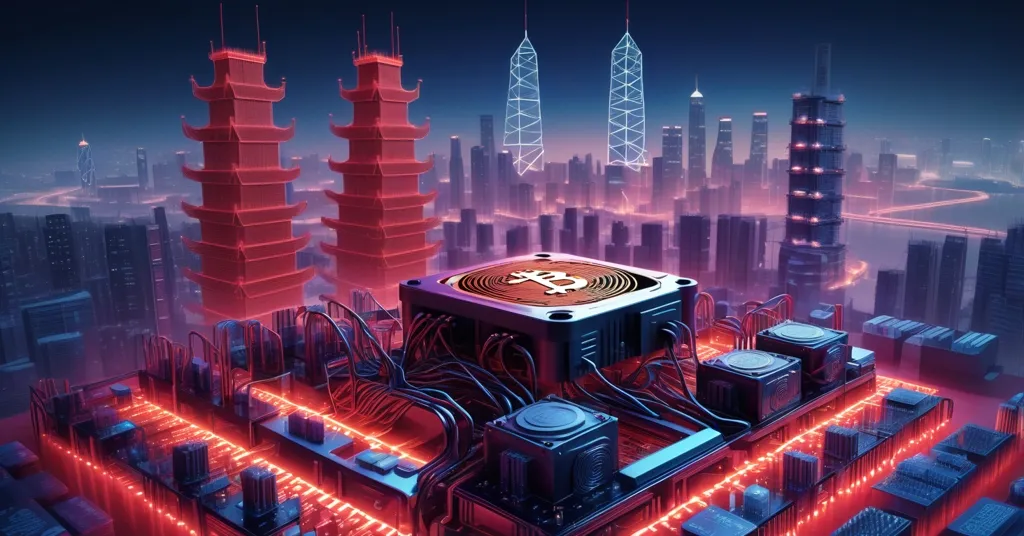China’s Chip Push: How Beijing’s Semiconductor Plan Impacts Bitcoin Mining

Beijing’s Semiconductor Gambit: A Make-or-Break Moment for Bitcoin and Blockchain Tech
Could China’s aggressive bid to dominate semiconductor production reshape the future of Bitcoin mining and blockchain infrastructure? As Beijing pushes to consolidate its fragmented chip industry into a global powerhouse, the stakes extend far beyond geopolitics—right into the heart of the crypto world. With US restrictions tightening and merger talks stalling, the outcome of this high-stakes game could dictate the cost, availability, and innovation of the hardware that powers decentralized networks.
- Core Struggle: Beijing’s state-led semiconductor mergers are faltering over valuation clashes and ownership disputes.
- Geopolitical Heat: US sanctions on chip tech are forcing China to seek self-reliance at breakneck speed.
- Crypto Impact: Success or failure could swing Bitcoin mining hardware costs and blockchain infrastructure stability worldwide.
China’s Chip Ambitions: A Strategic Power Play
China’s semiconductor industry has long been a patchwork of small, underpowered players, struggling to keep pace with global titans like TSMC or Intel. Enter Beijing’s grand plan: consolidate the sector into a handful of “national champions” capable of rivaling the best through state-orchestrated mergers. Spearheaded by the National Development and Reform Commission, this strategy aims to pool resources, cut redundancies, and scale up domestic production, as outlined in broader US semiconductor restrictions impacting China. The urgency is palpable, fueled by US export controls that block China’s access to cutting-edge chips and manufacturing tools—restrictions designed to curb its technological ascent and safeguard American dominance. With semiconductors underpinning everything from smartphones to military systems, and yes, Bitcoin mining rigs, self-reliance isn’t just an economic goal; it’s a national security imperative.
But let’s not kid ourselves—this isn’t a feel-good story of underdog triumph. The Chinese government has thrown staggering resources at this, with the China Integrated Circuit Investment Industry Fund pumping an estimated $150 billion into the sector, alongside a second fund of nearly $29 billion since 2019. Yet, for all the cash and rhetoric, China still produces only about 16% of its $143 billion domestic chip demand, a challenge detailed in resources like the overview of China’s semiconductor policies. The gap is a glaring vulnerability, and closing it through consolidation is proving to be a brutal slog.
Merger Chaos: When Ambition Meets Reality
The road to semiconductor supremacy is littered with stalled deals and bruised egos. Beijing’s merger talks with key chip equipment manufacturers have ground to a halt, mired in bitter disputes over ownership structures and valuations, as noted in recent reports on Beijing’s consolidation efforts. Sellers refuse to take a loss on their life’s work, while buyers—often state-backed entities—balk at paying inflated premiums. As one insider put it with unvarnished frustration:
“There were too many split interests. The prospective sellers don’t want to sell at a loss, and the buyers don’t want to pay a premium.”
The numbers tell an even uglier story. Of 26 semiconductor acquisitions announced in recent projections for 2025, eight have already collapsed, derailed by unresolved terms and clashing priorities. High-profile flops include Empyrean Technology, a leading Chinese firm in Electronic Design Automation (EDA—think software for designing and testing chip layouts), failing to acquire smaller rival Xpeedic, with deeper insights available in this analysis of failed Chinese chip acquisitions. Even more bizarre, companies far outside the tech sphere, like Zhejiang Aokang (a leather footwear maker) and Ningbo Cixing (a knitting machinery outfit), jumped into the chip acquisition game only to back out over valuation disputes. Apparently, crafting sneakers doesn’t qualify you to build cutting-edge silicon—who knew?
Amid the wreckage, there’s a glimmer of hope. A massive $16 billion merger between Hygon, a CPU designer for servers and data centers, and Sugon, a supercomputer manufacturer, is set to close via a share swap. This deal could create a heavyweight in high-performance computing, aligning with Beijing’s vision, as discussed in updates on Beijing’s 2025 semiconductor mergers. Edison Lee, a semiconductor analyst at Jefferies, sees potential, suggesting that such consolidation might finally build a self-sufficient ecosystem, slashing reliance on US giants like Applied Materials and Lam Research. But skepticism abounds. Lin Qingyuan from Bernstein warns that many target firms lack a true technological “moat”—that innovative edge needed to compete globally. Years of fragmented investments have burned cash without yielding profitability, raising doubts about whether bigger automatically means better.
Why Chips Matter to Crypto: A Deep Dive
Now, let’s pivot to why this messy saga hits home for Bitcoin enthusiasts and blockchain builders. Semiconductors aren’t just tech trivia—they’re the beating heart of the decentralized revolution. Bitcoin mining, the process of securing the network by solving complex mathematical puzzles, relies on specialized hardware called ASICs (Application-Specific Integrated Circuits). These custom-built chips are designed for one thing: maximizing computational power to mine Bitcoin efficiently. Without them, miners are dead in the water, and right now, the global supply chain for these chips is a geopolitical minefield, a topic explored in community discussions on China’s chip policies affecting Bitcoin mining.
Major players like Bitmain and Canaan, both Chinese firms, dominate the ASIC market but still lean on foreign tech for critical components—often sourced through complex international partnerships vulnerable to US sanctions. If Beijing’s consolidation succeeds, we could see a flood of cheaper, domestically produced chips, potentially disrupting current pricing models and making mining hardware more accessible, a possibility covered in reports on China’s semiconductor mergers impacting mining hardware. Imagine a world where mining farms in Texas or Kazakhstan aren’t at the mercy of global shortages or inflated costs. On the flip side, if China’s merged entities churn out subpar tech—lacking the efficiency or durability of established players—miners could face higher operational costs or reduced hash rates, squeezing profitability in an already cutthroat space.
Decentralization as the Ultimate Counterplay
Beyond mining, semiconductors power the broader blockchain ecosystem. High-performance computing—think GPUs and server chips—is essential for running full nodes (computers that validate transactions and maintain a blockchain’s integrity) and supporting decentralized applications (dApps) on networks like Ethereum. Even layer-2 scaling solutions, which aim to boost transaction speeds, depend on robust hardware. A hiccup in chip supply or a spike in costs due to US-China tensions could slow innovation across the crypto space, from DeFi platforms to NFT marketplaces, a concern raised in discussions on US sanctions affecting blockchain infrastructure. China’s chip push, while a top-down statist move that clashes with our decentralized ethos, inadvertently spotlights a glaring weakness: our reliance on centralized supply chains for the tools of freedom.
Risks, Opportunities, and Geopolitical Wildcards
Here’s where the crypto community can flip the script. While Beijing wrestles with state-driven mergers, we have a chance to champion true independence through decentralized solutions. Why should Bitcoin miners or blockchain developers be pawns in a geopolitical chess game, especially given the broader geopolitical tensions in semiconductor supply chains? Open-source hardware designs, community-driven manufacturing collectives, or even localized production hubs could sidestep reliance on any single nation’s tech agenda. Imagine a future where ASIC blueprints are shared freely among crypto OGs, or where 3D-printing tech lets small-scale miners build custom rigs without bowing to corporate or state overlords.
This isn’t just pie-in-the-sky dreaming—it’s a direct response to the vulnerabilities exposed by China’s chip saga. Our commitment to disruption and effective accelerationism (e/acc) demands that we accelerate innovation, not wait for governments or tech giants to solve our problems. Sure, it’s a long shot, and the upfront costs are daunting. But if there’s one thing the crypto space excels at, it’s turning systemic flaws into opportunities for radical change. Let’s not forget: Bitcoin itself was born from a rejection of centralized control. Why stop at currency when we can decentralize the very hardware that powers it?
Key Takeaways and Burning Questions
- What’s driving Beijing’s semiconductor consolidation obsession?
It’s a direct counterpunch to US restrictions blocking China’s access to advanced chips, aiming for a self-reliant industry to secure tech independence amid geopolitical warfare. - Why are so many chip mergers crashing and burning?
Valuation disputes and fragmented interests are killing deals—sellers won’t settle for less, buyers won’t overpay, and the resulting chaos has tanked 8 of 26 announced acquisitions. - How could China’s chip push impact Bitcoin mining hardware?
Success might flood the market with cheaper, homegrown ASICs, easing costs for miners; failure could worsen supply shortages, driving up prices if global tensions spike. - What’s the broader risk to blockchain infrastructure?
Chip supply disruptions or cost hikes could stall innovation in running nodes or scaling dApps, choking the growth of decentralized networks at a critical juncture. - Is there a decentralized fix for crypto’s hardware dependency?
Hell yes—open-source designs and community manufacturing could break our reliance on centralized supply chains, embodying the true spirit of Bitcoin’s rebellion against control. - Can China’s consolidated firms really challenge global chip giants?
The jury’s out. Deals like Hygon-Sugon show promise, but without a technological moat, skeptics argue Beijing’s just building bigger, not better, players in a cutthroat game.
What’s Next for Crypto in a Chip-Driven World?
Beijing’s semiconductor gamble is a high-wire act, balancing national pride, geopolitical survival, and technological ambition. For us in the crypto space, it’s both a warning and a wake-up call. The hardware that fuels Bitcoin mining and blockchain networks isn’t immune to the whims of state agendas or international spats. Whether China’s mergers soar or crash, the shockwaves will ripple through our ecosystem, challenging us to adapt or risk being left behind.
Yet, amidst the uncertainty, there’s a silver lining. This mess underscores the urgent need for crypto to lead with innovation—decentralized hardware solutions, community-driven supply chains, or outright rejection of centralized tech dependencies. Bitcoin didn’t disrupt finance by playing nice with the status quo, and neither should we. The future’s a battlefield, but damn if we aren’t built to fight for freedom on every front. Keep your eyes on this unfolding drama—it’s far from game over.



